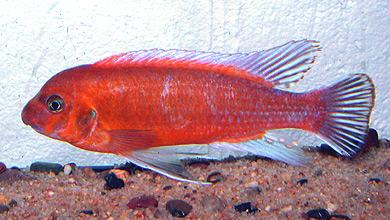Cichlid - Trewavasae
Trewavasae, Trewavas' Mbuna, Trewavas' Cichlid, Scrapermouth Mbuna Scientific Name: Labeotropheus trewavasae
Fri, 4th April, 2025 - 4:20 pm GMT
Sponsor Ads:

Alternative Name
Trewavasae, Trewavas' Mbuna, Trewavas' Cichlid, Scrapermouth Mbuna Scientific Name: Labeotropheus trewavasaeBasic Info
A mature Trewavasae Cichlid often measures 12 to 14 centimeters. It has a protruding upper jaw, often described as a hooked nose. Although many colorations are available depending on the region the Trewavasae Cichlid is native to, the most common has a red upperside. The rest of the fish is blue if it is male, and orange or orange blotched, if it is female. Again, however, other colorations may be available. For example, one common coloring is an orange blotched male, known as a "marmalade cat" pattern.
Health
Trewavasae Cichlids will require an enclosure of at least 25 gallons in volume. Temperatures for Trewavasae Cichlids should remain between 72 and 77 degrees Fahrenheit (21 and 25 degrees Celsius). The pH level should fall between seven and eight. Plenty of hiding areas should be provided, and live plants should be available, to be used for consumption. Often, rocks or PVC pipes will be heavily utilized. Substrates are not preferred, since Trewavasae Cichlids often dig in them, distributing dirt and detritus into their water. The sides of the enclosure should not be scraped during cleaning; however, water should be changed frequently. These fish are more sensitive than most to high ammonia levels. Trewavasae Cichlids do not usually do well with other fish because of their aggressive natures. However, they may be kept in groups of one male to multiple females in large enclosures. Normally, Trewavasae Cichlids eat algae off the sides of their enclosures. They should be fed small feeder fish and vegetable flakes. Plankton, brine shrimp, krill, and frozen bloodworms should all be offered. Algae based flake foods are a good choice. Live worms or brine shrimp should be offered from time to time. Many Trewavasae Cichlids also do well when their diets are supplemented with pellet food. Protein portions of their diets should be low compared to vegetable portions to help prevent the bloat that these fish are susceptible to. You should also try not to overfeed Trewavasae Cichlids. Breeding Male Trewavasae Cichlids can be identified by the presence of false egg spots on their anal fins, though some females may also have these. Often the anal fins of males are more pointed than those of females. Normally, setting up high female to male ratios in an enclosure can encourage breeding. The temperature should be raised to 80 degrees Fahrenheit (27 degrees Celsius), and a flat rock should be provided. Often a significant water replacement and a pH level of 8.5 can trigger breeding. A gravel substrate is not recommended, as the possibility of females taking gravel bits into their mouths along with their eggs is present. This could damage the eggs. Trewavasae Cichlids usually clean the rock with their mouths before depositing eggs on top of it. The female will then brood these eggs in her mouth. Although fry can be kept with other fish, you should try to move them into a separate enclosure by the time they are sexually mature to avoid aggression. Females holding eggs may also do better when kept in an enclosure by themselves. Separated holding Trewavasae Cichlids may be less stressed, and, because they will not have to move as much avoiding males or other fish, they may lose less weight during spawning. By the time the fry are between three and four weeks old, they will be released. Usually they can be fed a finely ground flake food, and supplementation with baby brine shrimp is said to aid them in developing color.Habitat
Fresh water fish - often make their homes in rocky areasBehavior
The Trewavasae Cichlid is an Mbuna type Cichlid that has interesting coloration and habits. These active fish can liven up an aquarium with their fast movements and beautiful hues, though care should be taken when combining them with other fish. In the wild, Trewavasae Cichlids often make their homes in rocky areas.Trewavasae Cichlids are normally aggressive and may bully other fish. They can, however be kept in groups of several females for each male. Normally, if Trewavasae Cichlids are kept with other Cichlids of similar size and temperament, incidences of aggression may be reduced so long as the aquarium is not overcrowded. Trewavasae Cichlids are usually quite lively and spend most of their time in the middle ranges of their enclosures. They can be quite interesting to observe.Origin
AfricaHistory
Trewavasae Cichlids are native to eastern Africa; specifically, they are found in Lake Malawi. They have become common in aquaculture and are adored by many enthusiasts.Common Foods
They use their modified snouts to feed on algae and also eat other fish.Sponsor Ads:
"Rouse him, and learn the principle of his activity or inactivity. Force him to reveal himself, so as to find out his vulnerable spots." -- Sun Tzu, The Art of War
Cichlid - Trewavasae
Coded by: BGID® | ALL RIGHTS RESERVED Copyright © 2000-2025
Disclaimer | Privacy | Report Errors / Contact | Credits


 Preparing For China. China is growing their military. China Military Technology - can it keep up with the US?
Preparing For China. China is growing their military. China Military Technology - can it keep up with the US?  versus
versus 

 versus
versus 
 This Thread is about the North Korean Military itself - the kind of army, navy, and air force they have.
This Thread is about the North Korean Military itself - the kind of army, navy, and air force they have. 
 versus
versus 
 versus
versus  versus
versus